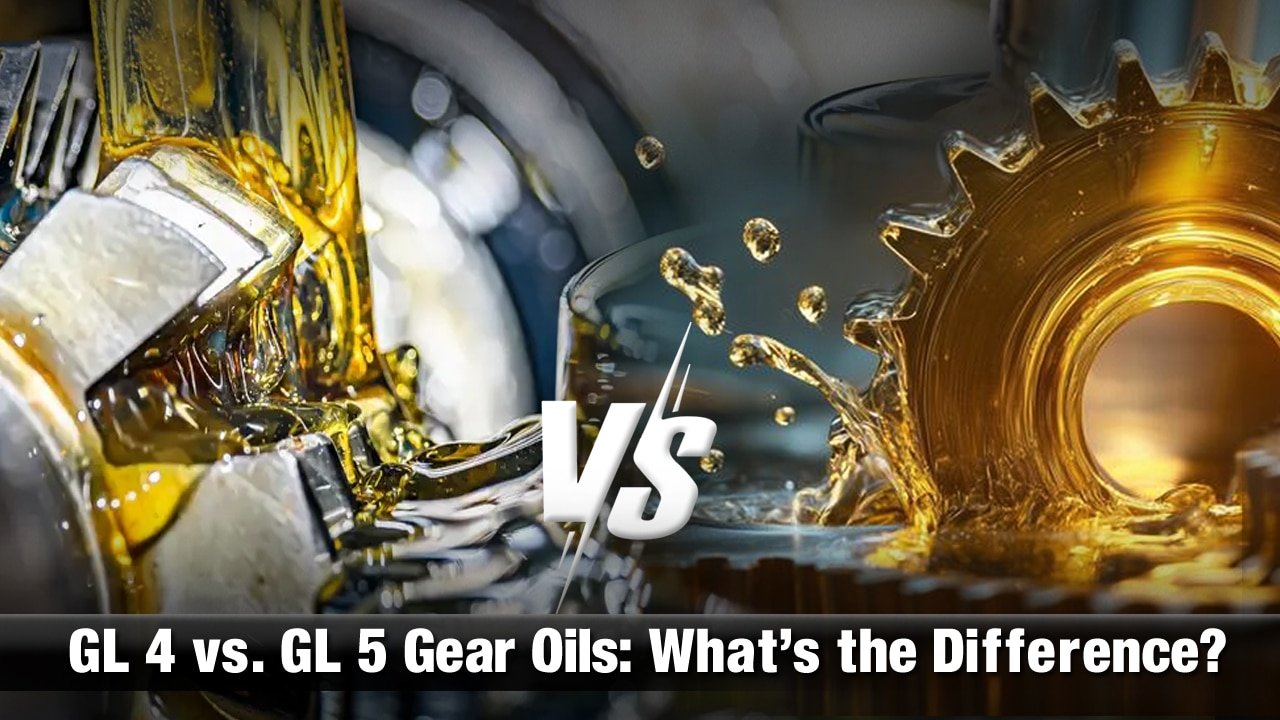
If you’ve ever changed your gear oil or looked into improving your vehicle’s performance, you’ve probably heard of GL-4 and GL-5 gear oil. At first, they might seem similar, but using the wrong one can cause severe damage. That’s why it’s so important to understand the difference between GL-4 and GL-5 gear oil. In this easy-to-follow guide, we’ll break down six key differences, explain when you can use GL-5 instead of GL-4, and help you figure out which one is more common.
We’ll even answer if gear oil can go bad over time. Let’s dive in and make gear oil simple, because the right oil means better performance and longer life for your vehicle.
What is the Difference Between GL4 and GL5 Gear Oil? – 6 Key Differences
GL4 and GL5 gear oils are made for different uses in vehicles, especially in gear systems. Here’s a simple look at the six significant differences between them:
1. EP Additives and Performance
GL5 gear oil has more EP (extreme pressure) additives than GL4 gear oil—about twice as much. These additives help protect gears that run at high speeds or carry heavy loads, like in car axles.
The EP additives create a layer over metal parts to stop them from rubbing and wearing out. That means GL5 gear oil gives better protection in harsh conditions.
2. Where They’re Used
GL4 gear oil is best suited for manual transmissions that operate under relatively low pressure and speed. It’s suitable for helical, spur, and some hypoid gears.
GL5 gear oil is made for hypoid gears in axles that handle high-speed and heavy-load conditions. If your car uses hypoid gears in demanding jobs, GL5 is usually the better choice.
3. Gear Protection
Both oils protect gears, but GL5 gear oil offers stronger protection because it has more EP additives. This makes it more resistant to wear, scoring, and heat.
GL4 gear oil still gives solid protection, but it is meant for lighter conditions.
4. Material Compatibility
GL5 gear oil can sometimes react with soft metals like bronze or copper found in older gearboxes. This may lead to damage or corrosion.
GL4 gear oil is gentler and usually safer for gearboxes with those materials. Always check what your gearbox needs before choosing.
5. Manufacturer Guidelines
Most manufacturers recommend GL4 gear oil for standard manual transmissions and GL5 gear oil for axles subjected to heavy-duty work. However, not all gearboxes can handle GL5 due to its strong additives.
Always follow your vehicle’s manual to pick the right oil.
6. Overall Usage
In short:
- GL4 gear oil is best suited for manual transmissions with moderate loads.
- GL5 gear oil is best suited for axles and gears operating under high pressure and speed.
Can I Use GL-5 Instead of GL-4?
Although GL-5 and GL-4 gear oils may seem similar, they are not the same. They are made for different jobs.
GL-5 gear oil has more extreme pressure (EP) additives. This makes it strong enough for heavy-duty work, like in axles and high-load gear systems.
GL-4 gear oil has fewer additives. It’s made for manual transmissions and lighter jobs. If you use GL-5 in a gearbox that requires GL-4, the extra additives can damage parts such as synchronizers.
To stay safe and protect your gearbox, always check the vehicle or gearbox manual. Using the right oil helps everything run smoothly and last longer.
What Is the Most Common Gear Oil – GL-4 or GL-5?
GL-4 gear oil is the most commonly used type in manual transmissions, especially in synchromesh gearboxes and transaxles.
GL-5 gear oil is also popular but is usually used in heavy-duty vehicles like trucks and SUVs. It has more extreme pressure (EP) additives than GL-4, which makes it better for high-load conditions.
Even though both are available, GL-4 gear oil is more common for everyday cars and standard manual transmissions. Always check your vehicle’s manual to know which one is right.
What Do API GL Ratings Mean?
The API (American Petroleum Institute) sets standards for oils and lubricants used in vehicles. In gear oils, the letters “GL” stand for Gear Lubricant. The number that comes after—like GL-4 or GL-5—indicates the amount of pressure and load the oil can withstand between gears.
It’s important to know that GL-4 and GL-5 are not quality levels. They are just made for different jobs. GL-4 is for manual transmissions, while GL-5 is for heavy-duty gear systems like those in axles.
Many people believe that GL-5 gear oil is superior due to its higher number. But that’s not true. Using the wrong type can damage your gears. Always pick the right GL rating based on your vehicle’s needs.
GL-4 Gear Oil: Made to Protect Synchronizers
GL-4 gear oil is designed with a moderate amount of EP (Extreme Pressure) additives. These additives help protect gears under usual driving conditions without damaging sensitive parts inside the transmission.
One reason GL-4 is so common in manual transmissions is that it’s safe for synchronizers. Synchronizers are essential for smooth gear shifting, and they’re often made from yellow metals like brass or bronze. Oils with too many EP additives—like GL-5—can wear down or corrode these soft metals.
GL-4 gear oil gives the right balance: it protects the gears but stays gentle on the synchronizers.
That’s why GL-4 is recommended for:
- Manual transmissions in cars
- Light commercial vehicles
- Farm equipment with synchronized gearboxes
At Fubex Lubricants, we make our gear oils to meet these needs, giving you reliable performance and protecting your gearbox for the long run.
GL-5: Built for Extreme Pressure and Heavy Loads
GL-5 gear oil is designed to operate effectively under harsh and extreme conditions. It has a lot more Extreme Pressure (EP) additives compared to GL-4. These special additives help protect the gears when they are under very high pressure and heat. That’s why GL-5 is the best choice for vehicles that use hypoid gear systems, like those found in differentials and final drives.
In these systems, the gears slide against each other, generating significant pressure and heat. GL-5 gear oil prevents metal parts from touching each other, ensuring everything runs smoothly, even under heavy loads.
But there’s something important to know. The same strong additives in GL-5 that make it great for heavy-duty parts can also harm certain parts in manual transmissions. If your transmission has yellow metal parts, such as brass or bronze synchronizers, using GL-5 for an extended period can cause damage. It can lead to rough gear shifting, faster wear, or even complete failure of the transmission.
When to Use GL-5 Gear Oil
GL-5 gear oil is the right choice for:
- Rear axles and differentials in both cars and commercial vehicles
- Hypoid gear systems with high sliding pressure
- Off-road vehicles and heavy-duty trucks
- Construction machines and mining equipment
At Fubex, we always recommend using the correct gear oil for the right system. Choosing GL-5 in the right place gives strong protection from wear, heat, rust, and damage, especially in hard-working vehicles and machines.
Also Read: What is GL5 Gear Oil – Understanding Its Benefits and Uses
Why the Difference Between GL-4 and GL-5 Matters
Even though GL-4 and GL-5 gear oils might seem similar, they are not interchangeable. This is something every car owner, mechanic, and technician should know.
Some people think GL-5 gear oil is just a stronger version of GL-4, but that’s not true; it can cause damage.
If you use GL-5 gear oil in a transmission that requires GL-4, the stronger EP additives can damage yellow metal parts, such as brass or bronze. This can lead to gear wear, poor shifting, or even total gearbox failure.
On the flip side, using GL-4 gear oil in a differential that needs GL-5 won’t give enough protection under heavy pressure. That can cause gears to wear out or break.
Always use the right gear oil for the job—it helps your vehicle last longer and run better.
Final Takeaways
As we finish up, remember that choosing between GL-4 and GL-5 gear oil isn’t just about picking one over the other. GL-5 gear oil is made for high pressure, heat, and heavy-duty work—perfect for axles and strict gear systems. On the other hand, GL-4 gear oil is excellent for older vehicles and manual transmissions that need gentler protection, especially for parts made of brass or bronze.
The most important thing? Always follow your vehicle manufacturer’s recommendation. That’s the safest way to make sure your gears stay protected and your vehicle runs its best.
In the end, the right choice depends on what your vehicle needs, and using the correct gear oil makes all the difference.
FAQs
Q1: Which is better, GL-4 or GL-5?
GL-4 is safer for gearboxes with brass or bronze parts due to fewer EP additives. GL-5 offers stronger protection for high-load systems but may damage soft metals. Choose based on your vehicle’s needs.
Q2: What is the difference between GL-4 and GL-5 gearbox oil?
GL-4 is used in manual transmissions with moderate speed and load. GL-5 is made for axles with hypoid gears under high pressure and heavy loads. Use each where it fits best.

Editor-at-Large
A passionate writer in the lubricant industry, Awais Iqbal has been covering oils, greases, and industrial fluids since the start of his career. At 25, he’s already written for blogs, catalogs, and brand guides across the UAE. Awais’s insights help companies connect with their audience, and his clear, helpful writing style is trusted by brands in the region.


